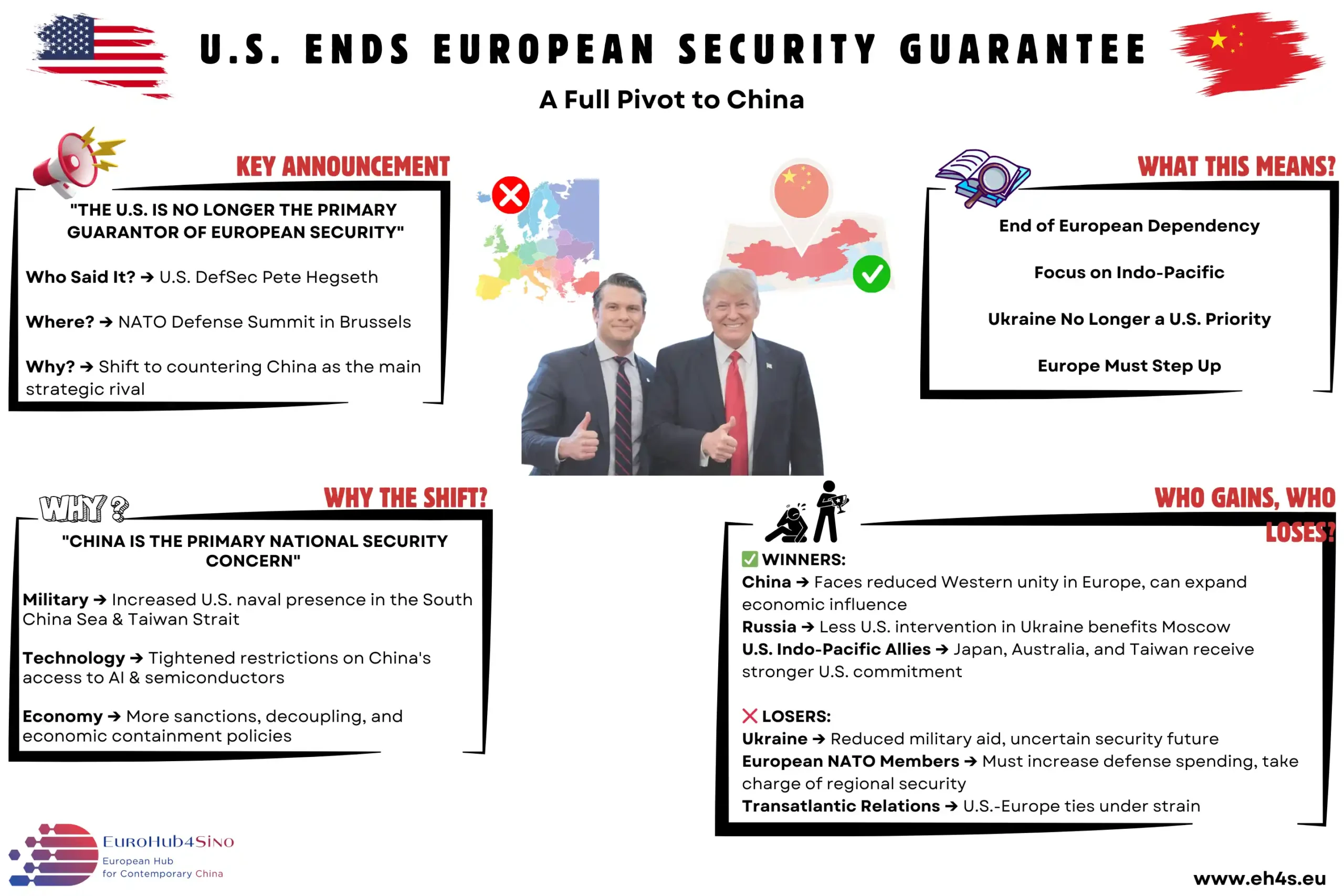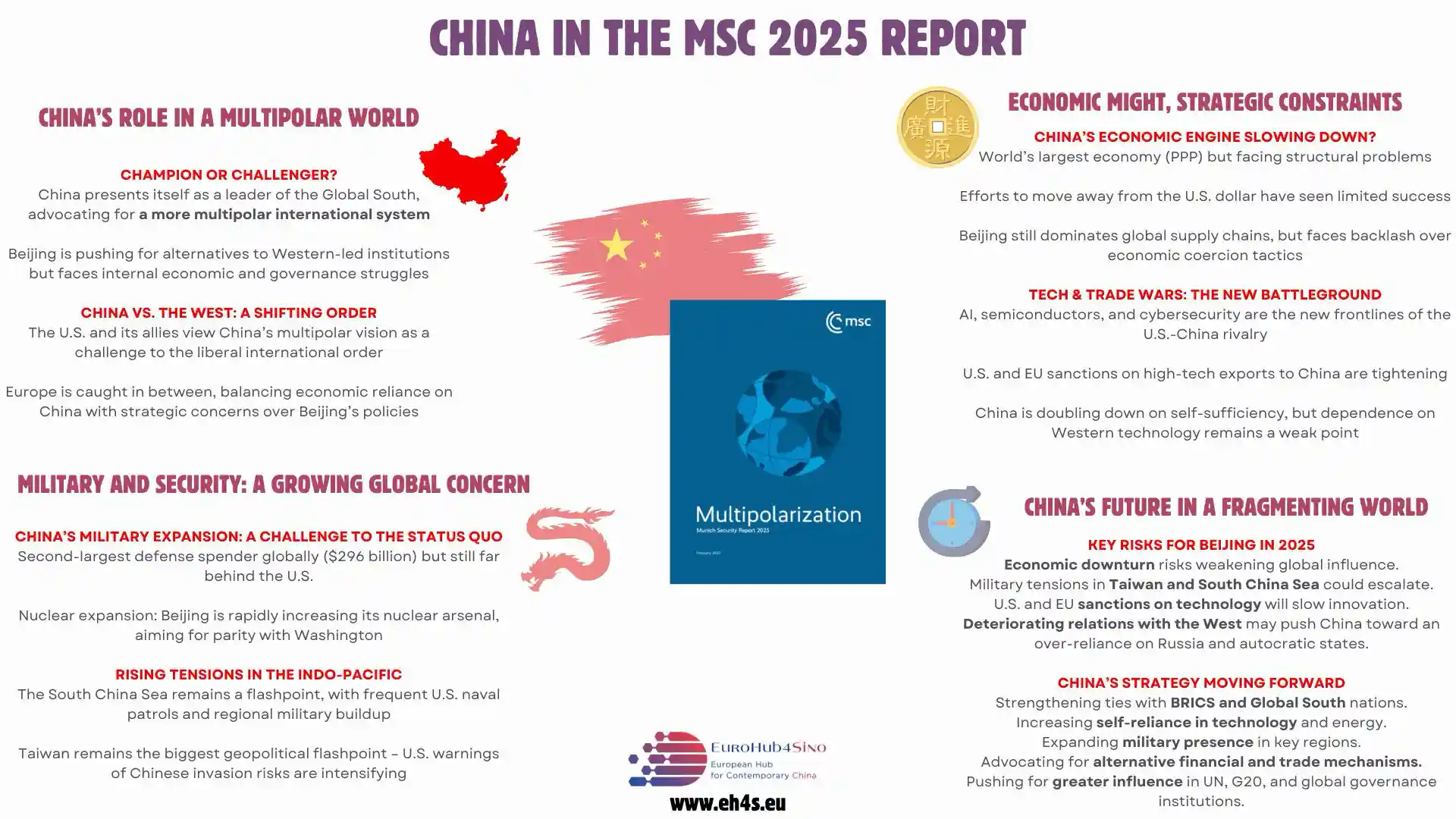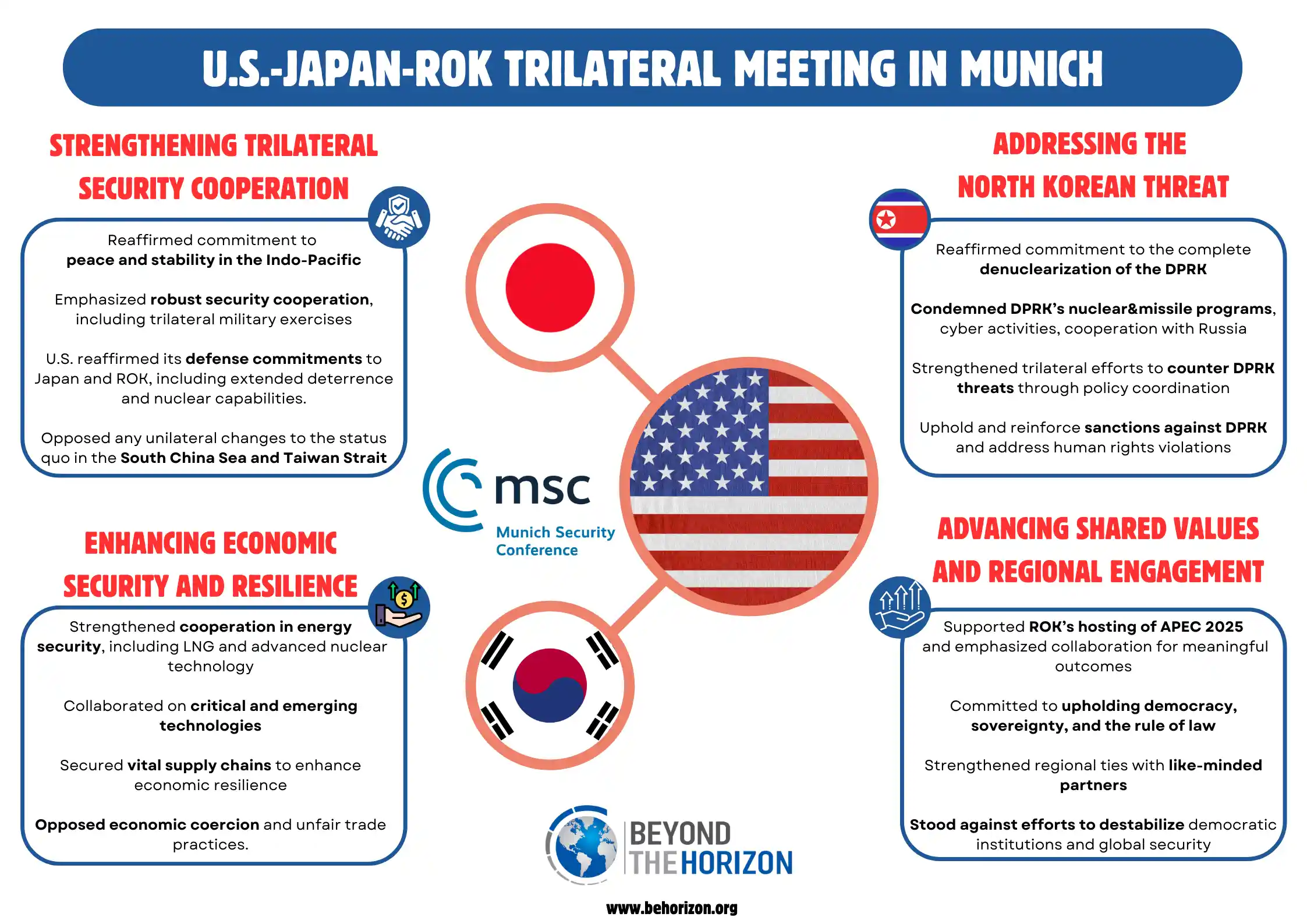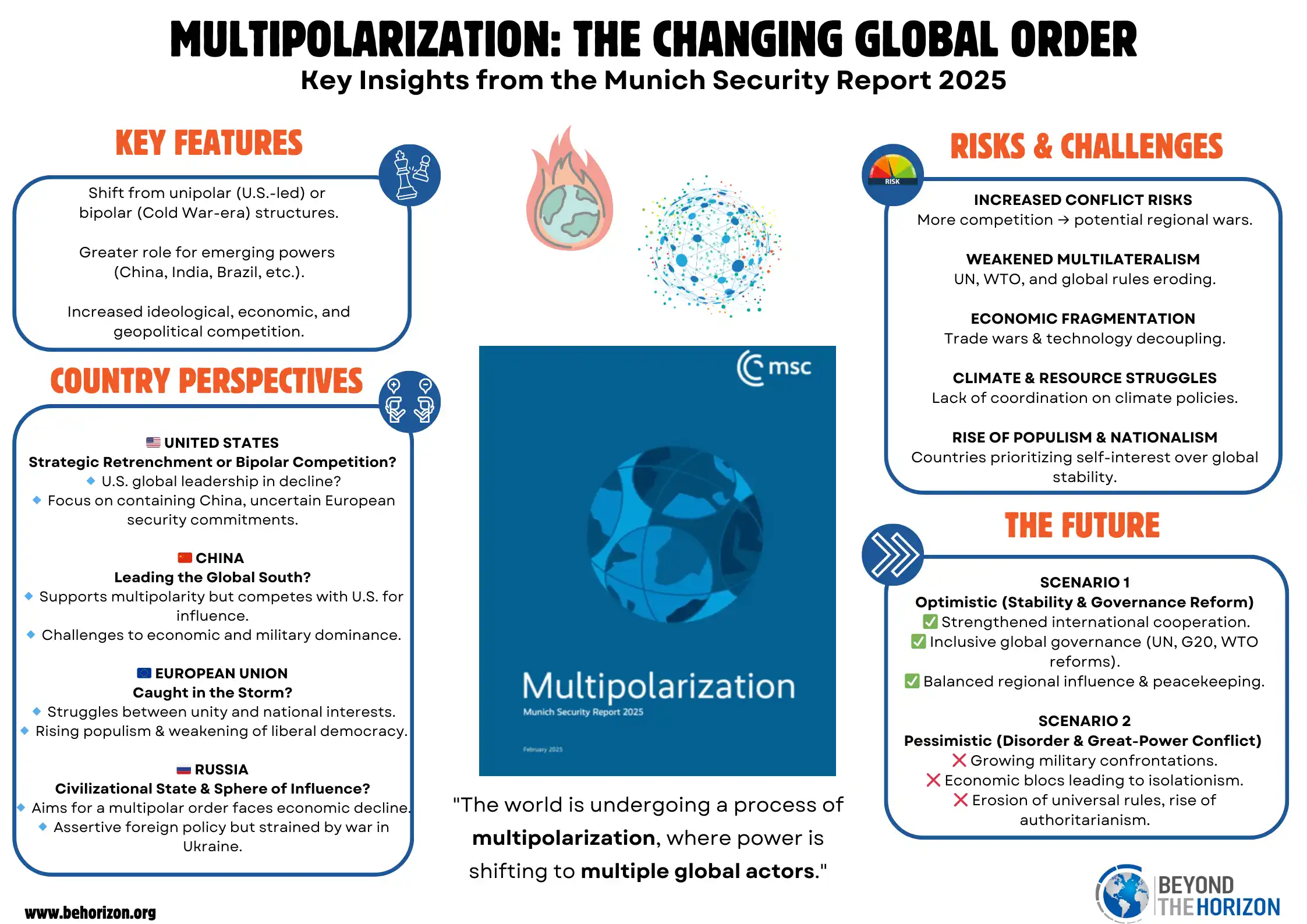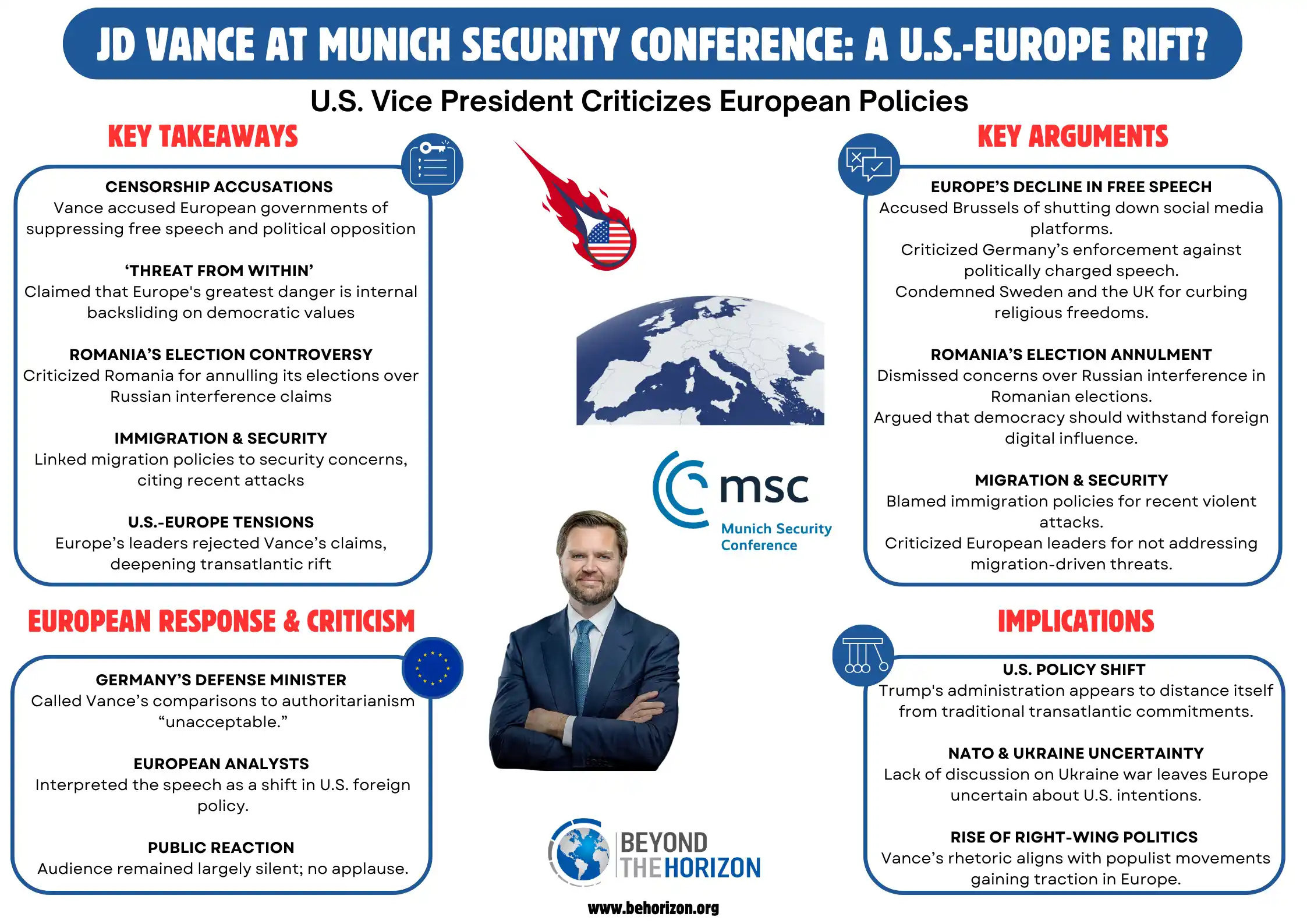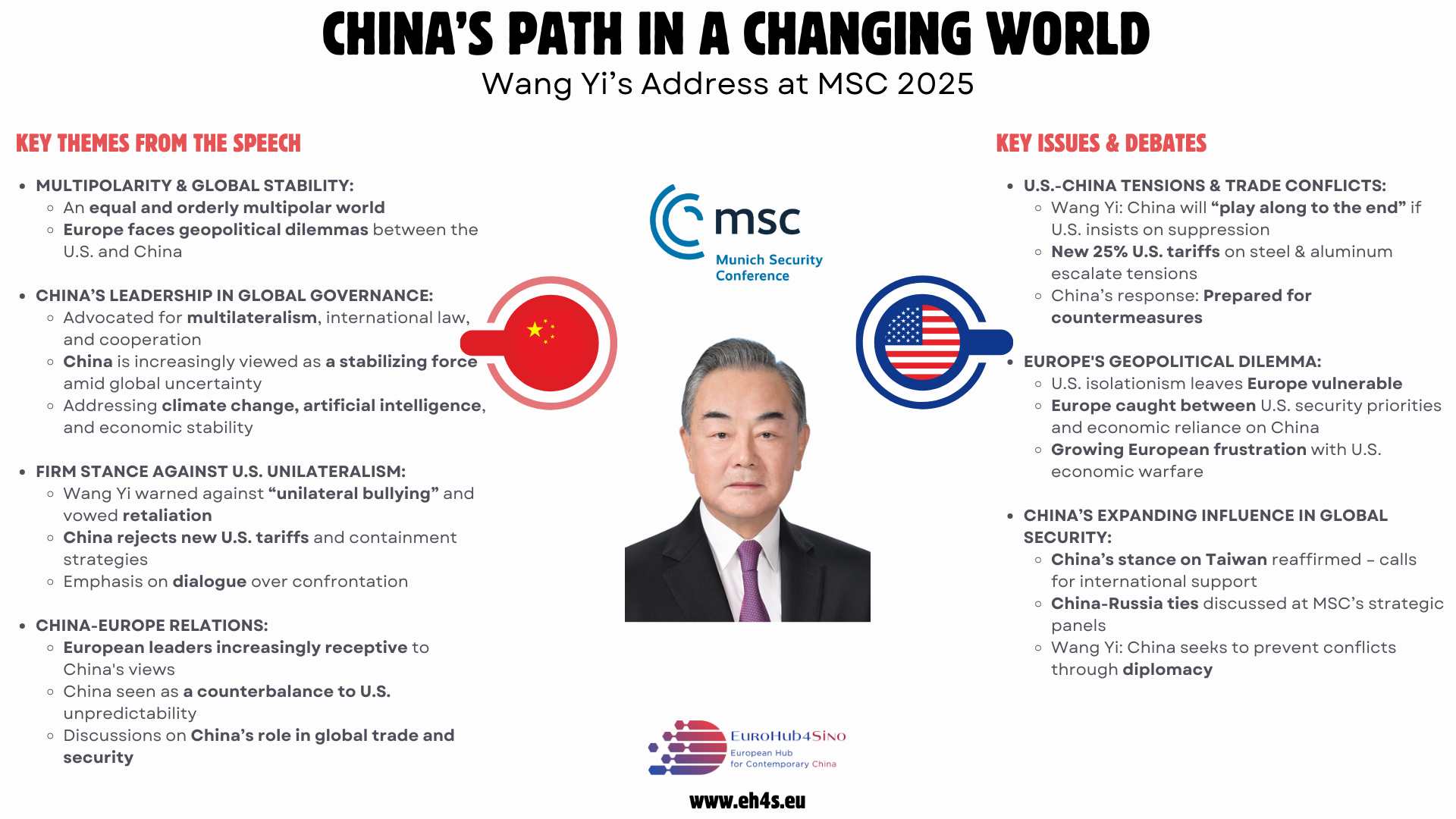Key Takeaways
- The US is stepping back from European security: For the first time in decades, Washington has signaled that Europe must assume primary responsibility for its own defense, reshaping NATO and altering the continent’s security dynamics.
- China is now the top US strategic priority: The Trump administration views China—not Russia—as America’s primary geopolitical rival, redirecting military and economic focus toward the Indo-Pacific while reducing commitments in Europe.
- Ukraine faces an uncertain future: With US military support decreasing and NATO membership ruled out, Ukraine must now rely on European allies to sustain its war effort against Russia.
- European nations must rapidly increase defense spending: The US is demanding that NATO members double their military budgets, raising the target from 2% to 5% of GDP, marking a major shift in burden-sharing expectations.
- NATO’s future is in question: With US leadership fading, the alliance must adapt or risk irrelevance, as European leaders debate the feasibility of a more autonomous defense structure.
- Russia and China stand to gain the most: Moscow could secure a more favorable outcome in Ukraine, while Beijing benefits from a weaker transatlantic alliance.
- Global order is shifting toward multipolarity: The decline of US leadership in Europe weakens international institutions and accelerates the rise of competing power blocs, such as BRICS and a strengthened Russia-China partnership.
- The US gamble: Will it strengthen or weaken its global influence? Washington is betting that Europe can defend itself while it confronts China—but if this gamble fails, it could undermine US global leadership and credibility.
Introduction
For more than seven decades, the United States has been the cornerstone of European security, shielding the continent from Soviet/Russian aggression, nuclear threats, and internal discord. Through NATO, successive US administrations have upheld the post-World War II order, reinforcing the transatlantic alliance as an unshakable pillar of global stability. But now, that era is ending. The US is stepping back.
In a stark and unequivocal declaration, US Secretary of Defense Pete Hegseth recently told NATO allies, “The United States is no longer the primary guarantor of European security.” These words, uttered at a high-level summit in Brussels, sent shockwaves through European capitals. For the first time in modern history, Washington is signaling that Europe must stand on its own.
The implications of this shift are profound. Ukraine, already battered by war, can no longer rely on American firepower and financial support. NATO, the bedrock of Western military deterrence, is being forced to reconfigure its role. And while European leaders scramble to fill the security vacuum left behind, Russia and China are watching closely, ready to exploit new opportunities.
This is not just a tactical maneuver—it is a strategic reorientation of US foreign policy. The Trump administration has decided that America’s greatest threat lies not in Moscow, but in Beijing. China is now the central focus of US military and economic strategy, and defending Europe has become, in the eyes of Washington, a secondary concern. This shift is reshaping the balance of global power.
But what does it really mean? Will Europe be able to step up and defend itself, or will this withdrawal invite new conflicts? Will Ukraine survive without US military backing? And does this signal the beginning of a larger US retreat from global leadership?
This analysis will explore the reasons behind America’s pivot away from Europe, its impact on global security, and the winners and losers in this dramatic geopolitical shift. The world is changing, and the consequences will be felt far beyond Brussels, Washington, or Kyiv.
The Strategic Rationale: Why the US is Pivoting Away from Europe
For decades, the United States has served as Europe’s ultimate security backstop, ensuring stability on the continent while deterring Soviet/Russian aggression. This commitment, however, has come at a steep cost—militarily, economically, and politically. Now, as the global balance of power shifts, Washington is making a calculated move: it is redefining its strategic priorities, and Europe is no longer at the top of the list.
The Shift Towards China as the Primary Rival
At the heart of this strategic pivot is the belief that China, not Russia, poses the most significant long-term challenge to American power. While Russia remains a regional threat, Beijing’s rapid rise as a technological, economic, and military superpower represents an existential challenge to US global dominance. The Trump administration, in particular, has made it clear that Washington’s future battles will not be fought over Ukraine but rather in the South China Sea, the Taiwan Strait, and the Indo-Pacific.
Shifting Security Burden to Europe
With China taking center stage in Washington’s grand strategy, the Trump administration has made it clear that Europe must now take full responsibility for its own security. The days of relying on American military might as a given are over.
- Increased Defense Spending Expectations: President Trump has long criticized NATO allies for what he sees as their “free-riding” on American defense spending. In Brussels, Defense Secretary Hegseth demanded that NATO members double their military budgets, raising the spending target from 2% to 5% of GDP. This is a radical departure from past expectations and signals that the US will no longer bear the financial burden of defending Europe alone.
- A New NATO Leadership Structure? With the US stepping back, the question arises: Can NATO function as an effective military alliance without Washington’s leadership? While European leaders like France’s Emmanuel Macron and Germany’s Olaf Scholz have advocated for greater European “strategic autonomy,” it remains unclear whether the continent can fill the vacuum left by the US.
- Reduced US Commitment to Ukraine: Perhaps the most immediate consequence of this shift is America’s diminishing role in Ukraine’s defense. Hegseth has categorically ruled out NATO membership for Ukraine and stated that any security guarantees must be upheld by European and non-European troops, not the US military. This marks a sharp break from the Biden administration’s approach, which viewed Ukraine as a frontline battleground in the fight against Russian expansionism.
The “America First” Doctrine and Its Consequences
At the core of this policy shift lies the “America First” doctrine, which prioritizes US domestic interests over long-standing international commitments. This doctrine has several major consequences:
- US Border and Homeland Security Over Foreign Commitments – The Trump administration has increasingly emphasized securing America’s borders over projecting power abroad. With growing domestic concerns about immigration, economic inequality, and crime, the administration argues that resources should be redirected toward internal stability rather than defending Europe.
- A Focus on Economic Self-Sufficiency – The administration’s policy of decoupling from global dependencies means that Washington is less interested in upholding the liberal international order that has defined post-Cold War US foreign policy. Instead of maintaining the US-led security umbrella over Europe, Washington is advocating for self-reliance.
- NATO: Still Relevant or a Relic of the Past? – President Trump has openly questioned NATO’s relevance, calling it an “obsolete” organization that needs a complete overhaul. While the US remains a member, it is clear that Washington no longer sees itself as the alliance’s default protector. Whether NATO can survive in this new paradigm remains to be seen.
The Broader Impact on the Global Order
The U.S. pivot away from Europe is more than just a shift in military priorities—it is a fundamental realignment of global power dynamics. As Washington focuses on China and reduces its direct involvement in European security, the international system faces a new period of uncertainty. The decline of U.S. leadership in the transatlantic alliance has profound implications for global security, economic stability, and the future of international institutions.
This section explores how the U.S. policy shift will reshape the global order, including risks, challenges, and possible future scenarios.
Risks and Challenges in the Post-US Security Landscape
The withdrawal of U.S. security guarantees to Europe is creating a more fragmented and unpredictable global order. Key risks and challenges include:
Increased Risk of Regional Conflicts
As the U.S. disengages from Europe, power vacuums are emerging, raising the likelihood of new regional conflicts:
- Eastern Europe and the Russian Threat: With the U.S. stepping back from Ukraine and NATO’s eastern flank, Russia may feel emboldened to test European resolve. The possibility of Russian aggression against the Baltic states or Moldova cannot be ruled out.
- Middle East and NATO’s Role: NATO has historically played a role in stabilizing the Middle East, with U.S. military backing. If Europe is forced to redirect military resources toward its own defense, it may be less able to contribute to counterterrorism and regional security efforts.
- Indo-Pacific Security: While Washington is shifting its focus to counter China, the U.S. may struggle to maintain its influence simultaneously in Europe and the Indo-Pacific. This could create an imbalance that benefits both China and Russia.
Weakened Multilateralism and Global Governance
The decline of U.S. leadership in Europe has broader consequences for global governance:
- Erosion of NATO’s Credibility: The U.S. has historically been the glue that holds NATO together. If Washington continues to distance itself, NATO risks becoming weaker or even obsolete.
- EU’s Struggle to Lead: The European Union lacks a unified military force and is politically divided. Without U.S. leadership, it remains unclear whether the EU can effectively coordinate collective defense and security policy.
- Weakening of International Institutions: The United Nations, World Trade Organization (WTO), and International Monetary Fund (IMF) have all been supported by strong U.S. leadership. If the U.S. continues retreating from global affairs, these institutions may struggle to maintain their legitimacy and effectiveness.
Economic Fragmentation and the Future of Global Trade
The U.S. retreat from Europe is happening against the backdrop of a global economic shift, leading to:
- Decoupling from China: As the U.S. prioritizes its economic battle with China, Washington is pressuring European allies to adopt a more aggressive stance on trade restrictions against Beijing. This could create economic divisions between the U.S. and Europe.
- Strengthening of BRICS: The BRICS nations (Brazil, Russia, India, China, and South Africa) have been actively challenging Western economic dominance. With a less unified West, BRICS could emerge as an alternative power bloc, promoting a multipolar global economy.
- European Defense Industry Growth: One unintended consequence of U.S. disengagement is the potential growth of Europe’s defense sector. As European nations increase military spending, European defense firms could see a surge in investment and innovation.
Future Scenarios: What Comes Next?
As the U.S. redefines its global strategy, there are three possible scenarios for the future of the global order:
- Scenario 1: Europe Successfully Fills the Security Vacuum
In this optimistic scenario:
- NATO transforms into a more European-led alliance, with Germany, France, and the UK taking on leadership roles.
- Europe significantly boosts its defense spending, meeting the 5% GDP target and modernizing its military capabilities.
- The EU integrates its defense structures, creating a coordinated European security framework.
- A strong U.S.-Europe relationship continues, albeit with Europe assuming a greater share of the burden.
Likelihood: Moderate. This scenario depends on whether European nations can overcome political divisions and work together to develop a strong, independent security structure.
- Scenario 2: A Fragmented and Weakened Europe
In this pessimistic scenario:
- Europe fails to increase its defense spending significantly, leaving it vulnerable to external threats.
- NATO becomes dysfunctional, as European nations struggle to replace U.S. leadership.
- Russia capitalizes on NATO’s weakness, expanding its influence in Eastern Europe.
- The U.S. gradually distances itself from European affairs, focusing entirely on the Indo-Pacific.
Likelihood: High. This scenario is already unfolding, with European leaders struggling to agree on a unified security approach.
- Scenario 3: A New Multipolar World Order
In this alternative scenario:
- China, Russia, and emerging economies form a more powerful counterbalance to Western influence.
- The U.S. maintains a strong military but becomes less involved in global governance.
- Europe seeks strategic partnerships with India, Japan, and other rising powers to compensate for U.S. disengagement.
- Global conflicts become more localized, with regional powers taking more responsibility for their security.
Likelihood: High. The rise of China, the decline of Western hegemony, and increasing global multipolarity all point toward this scenario becoming a reality.
Conclusion
For more than seven decades, the United States has stood as the guardian of European security, ensuring stability on the continent while shaping the global order through its military and economic dominance. That era is now coming to an end. Washington’s decision to withdraw from its role as Europe’s primary security guarantor is more than a policy shift—it is a fundamental recalibration of global power dynamics.
The implications of this transformation are profound. Europe is now forced to redefine its role in global security, with NATO at a crossroads, Russia poised to exploit new vulnerabilities, and China emerging as the primary focus of U.S. strategy. The old world order, defined by transatlantic unity and unquestioned American leadership, is fracturing, leaving uncertainty in its wake.
A New Test for Europe
The most immediate consequence of the U.S. withdrawal is the burden it places on European nations to step up and take responsibility for their own defense. NATO, once an alliance firmly anchored by U.S. military power, must now adapt to a reality where European members must either increase military spending, modernize their armed forces, and coordinate more effectively—or risk becoming irrelevant. The push for strategic autonomy, long advocated by France and Germany, is no longer an abstract goal but a necessity for survival.
Yet, the challenges are enormous. Many European nations are deeply divided over how to proceed, with Eastern European states calling for continued U.S. support, while others, like France, push for a more independent European defense structure. Meanwhile, the risk of a militarily weak and politically divided Europe could embolden adversaries, particularly Russia, which has already taken advantage of Western disunity in Ukraine.
The Gamble of U.S. Grand Strategy
For the United States, this is not simply a retreat—it is a strategic gamble. The Trump administration’s pivot toward China represents a fundamental shift in global priorities, one that could strengthen U.S. power in the Indo-Pacific but also weaken its alliances in Europe. The bet is that Europe can fend for itself, while Washington focuses on countering Beijing.
But what if the bet fails? If Europe is unable to coordinate its own defense, if NATO fractures, or if Russia expands its influence unchecked, the consequences could undermine U.S. global leadership in ways that no one in Washington anticipated. A world where U.S. allies no longer trust American commitments, where NATO weakens, and where authoritarian powers gain ground could be far more dangerous for the United States than the security burdens it is currently trying to escape.
The Winners and Losers of the New Global Order
In this new landscape, China and Russia stand to gain the most. Beijing benefits from a weakened transatlantic alliance, allowing it to expand its economic and military influence with fewer constraints. Russia, meanwhile, sees an opportunity to secure favorable terms in Ukraine, pressure Eastern European states, and exploit Western divisions.
The biggest losers in this shift are Ukraine and European NATO members. Ukraine now faces an existential crisis without a clear U.S. security guarantee, while European nations must scramble to fill the void left by Washington. The risk of European fragmentation, political instability, and security vulnerabilities has never been higher.
A Defining Moment for Global Stability
This is not just a European crisis—it is a moment of global realignment. The world is shifting from a unipolar order, dominated by the U.S., to a multipolar system where power is more distributed, alliances are fluid, and global stability is uncertain.
Europe must decide whether it can survive as an independent security actor or whether it remains permanently dependent on the United States. The U.S. must determine whether disengaging from Europe strengthens or ultimately weakens its global power. Meanwhile, China and Russia stand ready to exploit every opportunity this transition presents.
The choices made in the coming years will determine the shape of the 21st-century world order. Will Europe rise to the occasion and build a strong, autonomous defense framework? Or will it fragment under the weight of uncertainty and division? Will the U.S. emerge stronger in its confrontation with China, or will it weaken its global influence by abandoning key allies?
The answers to these questions will define the future. The old order is fading, and a new era of global power is beginning. The only certainty is that nothing will ever be the same again.
Related Infographics
